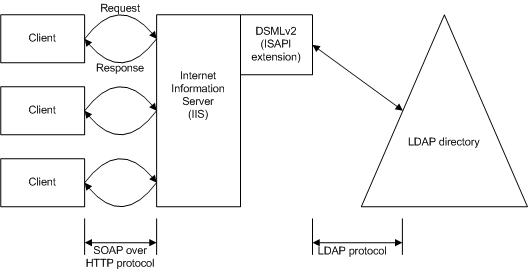SOAP Request and Response Binding
The SOAP Request and Response binding method uses SOAP to bind to a server. SOAP is a lightweight protocol for data exchange in a distributed environment and consists of:
- An envelope that defines a framework for describing what is in a message and how to process it.
- A set of encoding rules for expressing instances of application-defined data types.
- A convention for representing remote procedure calls and responses.
SOAP therefore defines the XML format for messages. For example, if you have a well-formed XML fragment consisting of a DSML V2 document enclosed in a pair of SOAP elements, you have a SOAP message.
This implementation of SOAP request/response binding uses HTTP 1.1 and HTTPS 1.1 as a transport for DSML V2 requests and responses. The version of SOAP used for this binding is SOAP 1.1.
The following illustration shows the data flow for a DSML V2 request and response.

In the preceding illustration, a client makes a request using the SOAP (XML) over HTTP protocol. That request goes to a server running IIS, where it is routed to a DSML V2 ISAPI extension. There, it is converted to LDAP commands, which are sent on to the directory services. The response occurs in a reverse fashion, with the response returning to the client through the SOAP over HTTP protocol.
Every SOAP request and response must have an envelope element that contains a body element, and a body element that contains the DSML V2 payload. The following code example shows the general form of a SOAP message:
<Envelope>
<Header>
All SOAP header elements go here
</Header>
<Body>
The DSML 2.0 payload (document) goes here
</Body>
</Envelope>
The <Envelope> and <Body> elements are required, but the <Header> element is optional. For more information about the SOAP specification, see http://www.w3.org/TR/SOAP and Using DSML Services for Windows.
The following code example shows a request/response message sequence:
<!-- **** DSMLv2 Request ****** -->
<se:Envelope xmlns:se="https://schemas.xmlsoap.org/soap/envelope/">
<se:Body xmlns:dsml="urn:oasis:names:tc:DSML:2:0:core">
<batchRequest>
<modifyRequest> <entity type="hellip"/> </modifyRequest>
<addRequest> <entity type="hellip"/> </addRequest>
<entity type="hellip"/>
</batchRequest>
</se:Body>
</se:Envelope>
<!-- **** DSMLv2 Response ****** -->
<soap:Envelope xmlns:soap="https://schemas.xmlsoap.org/soap/envelope/"
xmlns:xsi="http://www.w3.org/2001/XMLSchema-instance"
xmlns:xsd="http://www.w3.org/2001/XMLSchema"
xmlns:soapenc="https://schemas.xmlsoap.org/soap/encoding/">
<soap:Body>
<batchResponse xmlns="urn:oasis:names:tc:DSML:2:0:core"
xmlns:xsd="http://www.w3.org/2001/XMLSchema"
xmlns:xsi="http://www.w3.org/2001/XMLSchema-instance">
<modifyResponse> <entity type="hellip"/> </modifyResponse>
<addResponse> <entity type="hellip"/> </addResponse>
<entity type="hellip"/>
</batchResponse>
</soap:Body>
</soap:Envelope>
In the preceding example, be aware of the following:
- The namespace for DSML V2 is "urn:oasis:names:tc:DSML:2:0:core". This namespace is used at the top-level element of the <Body> of each SOAP request and is returned in the DSML V2 payload response. Default namespace designations may be used.
- All SOAP requests and responses in this binding must use UTF-8 encoding.
- Each SOAP request body contains a single DSML batchRequest.
- Each SOAP response body contains a single DSML batchResponse.